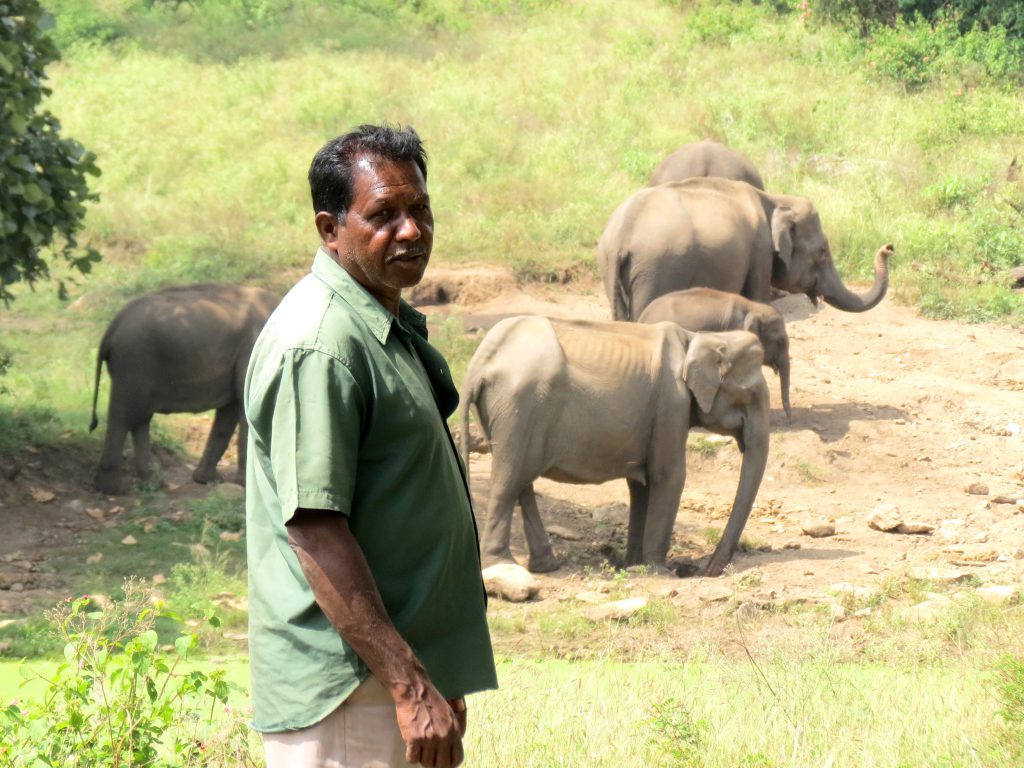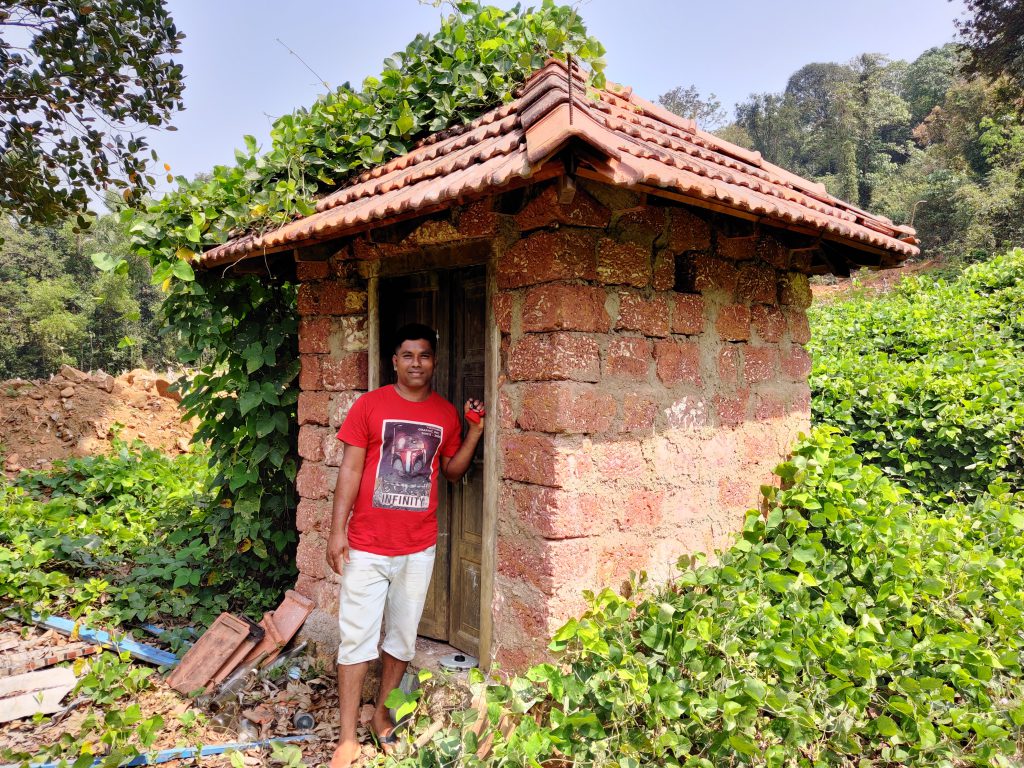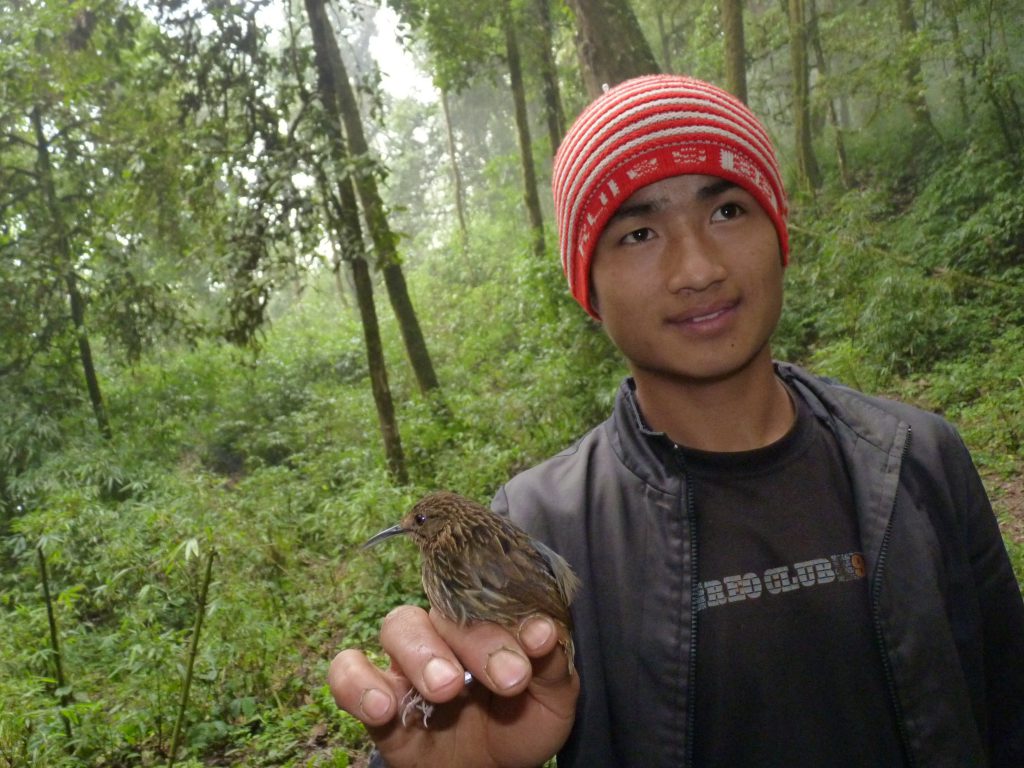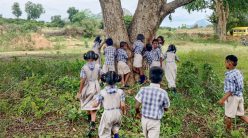Field assistants are critical yet underappreciated members of the ecological research community

When Raman Sukumar went to the forests of Mudumalai to study elephants for his PhD in 1978, he wanted a local person familiar with the terrain, and experienced at navigating elephant country to guide him. The forest rangers put him in touch with K Krishna, a Betta Kurumba Adivasi, to whom these forests were home.
In the 43 years that have passed since then, Raman, recently retired as Professor at the Centre for Ecological Sciences (CES) at IISc, has become a noted elephant biologist, and Krishna has assisted dozens of students and researchers on a wide variety of research topics. He has kept them out of harm’s way from potentially dangerous animals like elephants, bears and tigers. He is famous for his intricate knowledge of elephant behaviour. His sharp eyes can spot them from a great distance, and he knows exactly where and when to find them in the forest. “But he also has a respectful fear of elephants, and knows not to cross the line with them,” says Nachiketha Sharma, a visiting researcher in Raman’s lab, who has been studying elephant with Krishna since 2011. According to him, Krishna is probably the best elephant tracker in India, and has made an immense contribution to elephant research in the country.
Krishna also knows the botanical names of more than 100 tree species, as well as their Kannada and Tamil names. “Now, everyone who comes here is told, ‘Take Krishna along with you’,” he says. But Krishna is growing old now, and is not sure how long he will be able to continue helping the researchers. “They ask me, ‘After you, who will help with this field work?’ I will assist until I can, but I am also training my second son [to take up this work].”
They are unsung heroes in ecology
and conservation science
Most ecological research would be impossible without the assistance of people like Krishna. They are unsung heroes in ecology and conservation science. Unlike project trainees and assistants in other departments where field work is involved (such as the Centre for Earth Sciences, the Centre for Atmospheric and Oceanic Studies, and Civil Engineering), field assistants who are involved in ecological research typically do not have a Bachelor’s degree, and many of them may not even have finished their school education. Yet they play a role that can be far more important for certain areas of research.
Ecologists often work in unfamiliar areas far from cities. Local people who work as field assistants have an intimate knowledge of the area, and of the plants and animals there. They also help the ecologists navigate the terrain, and look out for danger. But they are often undervalued.
That is why faculty members at CES sent a letter to the Director in January 2021, requesting that a formal position called “field assistant” – originally established decades ago but defunct in recent years – be reinstated. Among them was Umesh Srinivasan, Assistant Professor at CES, who elaborates, “Field assistants are essential to the very pursuit of ecology. It seems unfair that people who are so critical to this scientific endeavour are neither formally recognised nor have any kind of official status.”
Kartik Shanker, Professor at CES, echoes this sentiment. He met his field assistant P Mayavan for the first time in 1992, when he was a PhD student studying rodents in the unique shola-grassland forests of the Nilgiris. The PhD fellowship during those days was Rs 1,800 per month, and the field assistant’s salary was Rs 900. “In the 20-plus years that have passed, my salary has gone up by a factor of nearly 150, but his only by 15. Every time I meet Mayavan, this never fails to cross my mind. This is something that is reflected in our society – that we credit formal education and not other types of knowledge.” “The problem is that because they don’t have degrees, they are not able to get an increase in salaries,” adds Rohini Balakrishnan, Professor at CES.

Facing risks in the field
“I think almost every one of us has had our lives saved by field assistants at some point,” says Rohini, whose lab conducts research in and around Kudremukh National Park. Sudhakar, a Malekudiya Adivasi who was born and brought up in those forests, has assisted her students since 1999. “He is a built-in GPS, a master tree climber and master improviser – these are invaluable assets. Our research could not have been done without him,” says Rohini.
Sudhakar says that he has enjoyed working with Rohini and her team for the past 21 years. “Other than insects, students keep coming to study different things – trees, bats and so on. Therefore, I don’t get bored,” he explains.
Most of the research that Rohini’s team carries out is on crickets and bats, which have to be studied at night, and this can often be frightening, and even dangerous. “We would keep starting at strange sounds and ask him what they were and he would simply say, ‘Praani’ [animal] and go off to sleep!”, says Rohini. “He could take us anywhere in the pitch dark, even off the path, and he could always bring us back. To this day, I don’t understand how he could navigate in those forests at night.”
Sudhakar shrugs it off. “I was born in the forest, so I am not scared of working at night.”
Mayavan also recalls how, at one time, along with two researchers, he came extremely close to a tusker elephant while they were out in the forest at night. “It was a new area and we didn’t know the tracks. We somehow escaped with torn clothes and lost slippers.”
Bridging the cultural gap
People like Mayavan and Sudhakar also act as a bridge between researchers and the locals. “Without the crucial local knowledge of landscapes or seascapes or even social mores or customs, how do you talk about your research to people who are from that area?” says Umesh. Field assistants provide valuable insights that come from a lifetime of experience living or working in an area.
For instance, Rohini’s students have been able to study some bat roosts only because they are in the plantations of Sudhakar’s friends. In many rural areas, including the villages of Kudremukh, tiled roofs are becoming a thing of the past, and as a result, bats are losing their roosting spots. These villages traditionally had a small tiled building dedicated to a specific deity, known as a bhoothasthana. “These are uncommon now, but they used to be a favourite place for bats to roost,” says Sudhakar. With his help, Rohini and her team asked the locals if they could build equivalents of these bhoothasthanas on their lands, and a few people agreed. Sudhakar built the first one with his own hands last year, and nine bats have already made it their home. “We are now encouraged and want to do this on a larger scale,” says Rohini. “A lot of things have opened up for us because of his connections in that area.”

Like Sudhakar, Manjunath K Reddy has been helping Rohini’s students study crickets since 2009. Hailing from Ullodu village in Chikkaballapura district, Manju belongs to a family of farmers. He enjoys working on the land too, but as long as his parents continue to farm, he would rather catch crickets. “This is where my interest lies,” he says. “When I first started working with the PhD students, the rest of the village wondered what kind of strange work this was: catching insects. ‘What do you get out of that?’ they would ask me.”
Viraj Torsekar, a former PhD student, says that the lab’s relationship with Manju is one that has been treasured across academic batches. “He really took ownership of your project,” he says. He recalls an incident from the fourth year of his PhD, when he was panicking as he had not been able to finish his experiments in the field due to circumstances out of his control. The weather was too cold, and the crickets were not very active. They installed heaters on top of the enclosure that was being used for Viraj’s experiments, but they needed a long and durable cable to connect the power line to the heaters, which was quite expensive. Manju offered to go home and get a spare one from his village. When Viraj went to the bus stand to meet Manju on his return, he was amazed. “The cable was long and quite heavy! I really got a little emotional at that point about the fact that he was investing so much time and effort into something that wasn’t working.” When he asked Manju why, the latter replied, “Everyone’s project that I have helped with has worked. This too has to work; there is no way that it cannot.”

Manju was also responsible for looking after the crickets in the “culture” room, where all the insects used in behavioural experiments are kept. This involves putting food and water every day into hundreds of containers that house the crickets, and making sure that the containers are clean and there are no signs of fungus in them.
At one time, when Manju was watching over a batch of crickets being studied by Rochishnu Dutta, another former PhD student in Rohini’s lab, he was perplexed to see that some of the healthy individuals were suddenly dying. He found a small black pellet in the containers of these dead animals. Initially, he thought that it was some kind of dropping and discarded it. But the crickets kept dying and the pellet kept turning up. At his insistence, Rochishnu examined the pellet under the microscope, and to their astonishment, they discovered that it was the pupa of a Tachinid fly – known to be a parasitoid of crickets. While these flies are well studied elsewhere in the world, practically nothing is known about them in India. This was a new discovery that was published in the Journal of Orthoptera Research, a paper on which Manju is also an author. “Manju was critical to this discovery and so I included his name,” says Rochishnu, explaining his unconventional decision. “It is my tribute to him. My only regret is that it is not available in Kannada so that Manju can read about his
contribution to science.”
A unique bond
Although they are considered employees, they often become friends, philosophers and guides to the many researchers they work with. “With every trip to the field, they become closer to you. In fact, I learnt Kannada from Sudhakar and Manju,” says Rochishnu.
When Manju’s finger was gravely injured in an accident on his farm, students from Rohini’s lab pooled in money for the plastic surgery that was required to save his hand. Manju has been to many students’ weddings, and the students have, in turn, attended several in his village. He confesses, “Only after starting this work did I realise that city youth can also be friends with rural youth. I have worked with so many students, and now I consider many of them my ‘aatma geleyagalu’ [soulmates]. No one treated me differently because I was from a village.”
Sudhakar also keeps a framed photo of himself with Manjari Jain and H Raghuram, former researchers from Rohini’s lab, in his house. “In all these years, I have been closest to them. We worked together like friends. I am in regular touch with Raghuram,” he says.
“At this point, they are not even field assistants anymore, they’re family,”
Umesh agrees. “At this point, they are not even field assistants anymore, they’re family,” he says. His lab studies the effects of climate change and deforestation on bird communities at the Eaglenest Wildlife Sanctuary in Arunachal Pradesh. Umesh has been working with the same crew of six field assistants since 2011. He has no reservations about sending new students there on their own, as he knows that they will be in able hands. Among his crew is Micah Rai, better known as Kami. “When we first started working with Umesh, we just waited for the month to end so that we would get our salary,” he admits. Umesh then started handing out prizes to the person that could spot and identify the most number of birds, and that got Kami and the others hooked. “We could perhaps earn more if we went back to farming, but now we really like this work. Every year, when Umesh comes from Bangalore, he explains the findings of his research to us, and that also keeps us interested,” he says.

Mayavan also divulges that his interest in field work hasn’t dimmed even after so many years, and he is happy to have helped Kartik build his career in academia. “As long as I am able to, I will continue to work with Kartik sir,” he says.
For his part, Kartik says, “I’ve remained Mayavan’s employer, but he’s also a friend. Whenever I go to the Nilgiris, I like to drive up and visit his family.” He points out that field assistants like Mayavan also bring a different perspective to life, to knowledge, and to our engagement with nature and the environment. “The relationship that we end up building with them really enriches our lives. We’ve gotten so much from them; we have to find a way to give back.”
With input from Ranjini Raghunath




